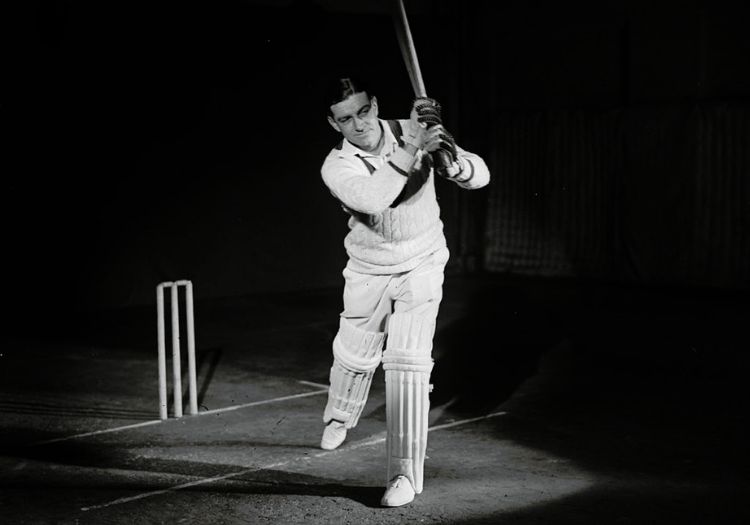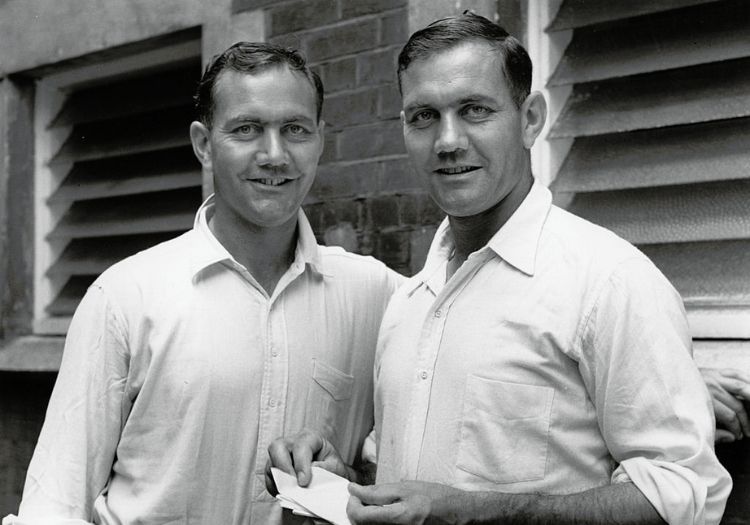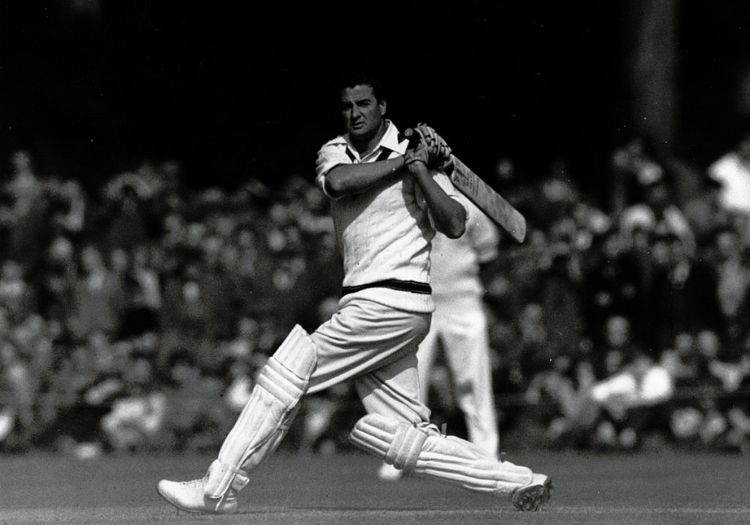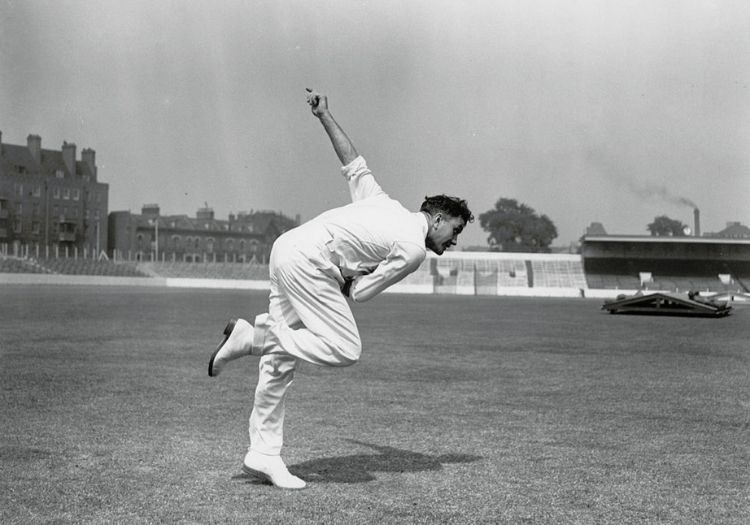HUW TURBERVILL: It was the first Ashes series after the War, and offered the Australian and English public a reassuring sign that the world was returning to normal.

“A fine f***ing way to start a series.”’
England captain Walter Hammond was not amused.
It was the first morning of the 1946/47 Ashes, at Brisbane, and the tourists believed they had dismissed Don Bradman.
He’d made 28 uncertain runs when he’d tried to guide a yorker-length ball from Nottinghamshire left-arm seamer Bill Voce, Harold Larwood’s sidekick in the Bodyline series and on special army leave, down to the third man boundary. Lancashire’s Jack Ikin, at second slip, comfortably took the ‘catch’, and so certain were the fielders that they’d dismissed Australia’s captain that they did not even bother to appeal.
That Bradman had hit the ball was not in dispute, but by standing his ground, he was implying that he believed it was a bump-ball, that he had squeezed it into the ground. He was given not out by umpire George Borwick, the New South Wales umpire.
It was all too much for Hammond, who made his intemperate remark, which was shockingly rude at the time. Paul Gibb, the England wicketkeeper, suggested: “The umpire was either unwilling or afraid to give a decision against a man of so high an authority in the Australian cricket world.”
Norman Yardley, the England vice-captain at gully, was also certain that the tourists had suffered an injustice. “I watched the ball bounce from the turf on to the top edge of the bat and go from there straight into Ikin’s hands,’” he said. “Everyone on our side looked in blank amazement and Hammond particularly seemed to be wondering what to do next. Bradman still looked down. A ball chopped at that speed bounces steeply up… it does not travel parallel with the ground at chest height.’”
Keith Miller, making his Test debut, was next in, and he said: "As Ikin held the ball, I instinctively got out of my seat, grabbed my gloves and picked up my bat, my heart pumping like a runaway motor out of control.”
As for Bradman, he said: ‘“I heard an appeal, the umpire indicated not out, so I batted on. Naturally, if I’d thought I was out, I should not have stayed there.”

Wally Hammond
It was a pivotal moment in the Test, and the series, as he made the most of his reprieve. He scored 187, and Australia totalled 645. They went on to win the match by an innings and 332 runs, and, ultimately, the series 3-0. Notwithstanding the legitimacy of the decision, it was an exceptional effort by Bradman, who was one of Australia’s three selectors, because it had been widely feared that he was in decline after the Second World War had interrupted his Test career. He had scored 5,093 pre-War Test runs at an average of 97.94, and here he was being presented with an unwarranted second chance. No wonder England fumed.
Bradman first served first in the Royal Australian Air Force, and was then appointed a supervisor of physical training in the Army. He had been invalided out, however, because of fibrositis and also, bizarrely, because of poor eyesight. He’d also been suffering from a shoulder injury and gastritis, which had left him a stone lighter. Ahead of the first Test, Denis Compton, rather unwisely, commented: ‘“Some of us wondered whether or not he was due for a nursing home rather than a cricket pitch.” Bradman’s knock, spanning 313 balls and lasting 316 minutes, gave Compton his answer.
Alec Bedser, who was at short-leg, was less certain his side had been unfairly denied anyhow, and told me: ‘“It was debatable. I saw an identical incident the other day on television, with the bat hitting down on the ball, and that was given not out. It was going very fast, and Don’s bat might have squeezed it into the ground. Either that or it might have flown off the pitch, or even a pad. Put it this way, I wouldn’t have liked to have had to give it. I know the skipper was upset, but most of us just walked away and got on with it – there was no disputing the umpire in those days. No controversy.”
Despite having to bowl at him, Bedser is certain that Bradman’s reprieve that day was good for cricket. ‘“He had been struggling so much,” he said. “For his first 50 runs he’d scraped all over the place. I think if he’d been dismissed cheaply he would have packed it in, and then we would not have come to England in 1948 [his farewell series, when he made two centuries and struck 508 runs].” Bradman played another 15 Tests after the War, making 1,903 runs at 105.72, to leave him with a career total of 6,996 and that famous average of 99.94.
"We left Southampton for Australia on the RMS Stirling on the last day in August knowing we wouldn’t be back until April 1947... eight months. We played 26 matches, but I didn’t want to come home"
Alec Bedser
The flashpoint also concentrated the minds of players who had previously felt merely an overwhelming sense of relief and happiness that they were on a field playing sport at all. It was the first Ashes series after the War, and offered the Australian and English public a reassuring sign that the world was returning to normal.
All 22 players knew how lucky they were to survive the conflict, only having to think about how Hedley Verity had not. The Yorkshire left-arm spinner, who took 144 wickets in 40 Tests at 24.37 apiece, was shot in the chest in Catania, Italy, in 1943, while serving as a captain in the Green Howards in 1943. He died of his wounds in a prisoner of war camp aged 38.
It was a boom period for Australia, with hundreds of thousands of refugees and migrants arriving to start new lives, and Bedser was as happy to be there as anyone. If some Australians still had gripes about the sacrifices they had made helping the Allies, or were continuing to harbour grudges about the infamous ‘Bodyline’ series of 1932-33, or the sacrifices at the Battle for Gallipoli in 1915, he did not encounter them.
Bedser outlived everyone who played in that series, and had just become England’s oldest living Test cricketer before he passed away in April 2010, at the age of 91.
I had the pleasure of interviewing him twice. The first time, just before England’s 2006-07 tour to Australia, he was in fine fettle, still playing golf, still driving to his beloved Oval. The second time – for what I believe was his final interview – was about six months before his death, and his health had declined visibly declined. He had been scalded in his shower, and then picked up an infection in hospital. It was upsetting to see a seemingly indomitable warrior fading physically.

Alec and Eric Bedser
Both interviews were conducted in the house in Woking that he and his beloved twin brother Eric, who died in 2006, helped their father build in 1953.
He was still mentally brilliant, though. One or two players, 20 years or more his junior, whom I tried to contact could hardly recall a thing, and yet were 20 years or more younger. Some, sadly, had been ravaged by dementia, but not Bedser.
His house was off the beaten track – I had to ask a postman for directions. I am glad I found it. Although he had a slightly authoritative manner, he was warm enough, and he was extremely accommodating with his time – and he proved to be a minefield goldmine of information.
He had fascinating tales to recount, occasionally using a cricket trinket on his mantelpiece, or nestling on the sofa next to his favourite chair, as a reference point. Opposite that chair, above the fireplace, was a stunning oil painting of him in his Marylebone Cricket Club blazer (touring England teams played as the MCC up until the mid-1970s, and still wore the colours until the mid-90s).
He played in five Ashes series, including three tours, and managed England in Australia on three others. He was a selector for 23 years and was their chairman of selectors from 1969 to 1981, famously falling out with Ian Botham, who was captain for the first two Tests of that legendary Ashes summer 40 years ago.
The 1946/47 tour was hastily arranged. MCC were reluctant to send a team so soon after the War, but the Australian Board of Control were insistent, and a personal request by Dr Herbert Vere Evatt, the deputy leader of the ruling Australian Labour party, helped sway the English decision.
The Ashes were contested over the traditional five Tests (each of six five-hour days each). The tourists also played, as MCC, against Western Australia, a Combined XI in Perth, South Australia, Victoria (they beat the Sheffield Shield champions), an Australian XI at Melbourne (essentially a Test trial for both sides), New South Wales and Queensland before the Test series even began. There was no question of England being under-prepared, an accusation levelled at some modern touring parties, although abnormally bad weather did deprive some of the fringe players of opportunities.
Interestingly, they travelled by air for the first time when they were forced to take a night flight from Adelaide to Melbourne because of a railway strike.
“I’d served in North Africa for two and a half years and was then demobbed in 1946,’” Bedser said. “I hadn’t played in that time – never touched a bat or ball. I reported for Surrey duty at The Oval on April 15, 1946, and after eight first-class matches I made my Test debut against India at the age of 28. It was ‘All India’ back then, and they were a good side.”
Bedser took 11 wickets in each of his first two Tests to secure his place on that winter’s trip to Australia and New Zealand.
“We left Southampton for Australia on the RMS Stirling on the last day in August knowing we wouldn’t be back until April 1947 ... eight months. We played 26 matches, but I didn’t want to come home.
“We went by sea. It took three weeks in a Ministry of War transport carrier. There were 16 players, a manager, a baggage man, and we then had a local physio when we arrived. There were no replacements if players broke down. I laugh seeing the people out there now – there are more hangers-on than players!

Keith Miller
“There was no running round the decks on the journey. I had just bowled 1,200 overs in England so it was a nice rest. We landed at Fremantle, then we travelled all around Australia by train.”
Bedser received a basic fee of £550 for the trip, with maximum bonuses of up to £263, plus £15 to spend on ship and another £2 per week in Australia and New Zealand. He said: “It was wonderful, especially playing the up-country games, meeting the locals, the true Australians. They were wonderful people. I made friends for life. The players just sit in their hotels now.’”
The previous Ashes series, in England in 1938, had been drawn 1-1. Australia retained the Ashes, however, after winning at home, 3-2, in 1936/37. They also won 2-1 in England in 1934. It was no great surprise, therefore, when they triumphed in Brisbane, in the first Test, to be played in Queensland’s state capital.
Pitches were uncovered, and violent thunderstorms gave England’s batsmen the worst of the conditions in each of their innings. Just under 100 minutes’ of play were possible on day three, and a further three hours were lost the next.
Miller, the New South Wales allrounder, had been stationed in England during the War, and impressed for the Imperial Forces XI in the Victory Tests there in 1945.
His bowling had always been under-rated, but he took 7 for 60 at Brisbane as England were dismissed for 141 in the first innings. Bill Edrich, of Middlesex, a magnificent player of short-pitched bowling, made 16 in 98 minutes. The Wisden correspondent wrote: “It was one of the most skilful batting displays he’d ever seen”, and noted that Edrich was hit 10 times. Then, after the later, more violent storm, during which the stumps and covers floated away and the pavilion was struck by hailstones, the tourists fared only slightly better second time around, scoring 172. The tall left-arm seamer with film-star looks, Ernie Toshack, from New South Wales, recorded figures of 6 for 82, giving him match figures of 9 for 99.
It was a demoralising defeat for England, but Bedser, for one, was not surprised. He said: ‘“We were all pre-War cricketers. And only three of us were under 30 – Jack Ikin, Godfrey Evans and myself. The Australians were much younger than us. Denis Compton was just about 30 [actually, he was 28]. All the rest were 35 and 36. The fact is that they weren’t very good anymore. You wouldn’t expect them to be. They were all finished, but there was no one else to pick because of the War.
“Some of the Australians had played on during the War. Arthur Morris didn’t, but some did, not state cricket, but grade cricket, which carried on.”
"There was no air-conditioning in Australia, and the pubs closed at six so the teams shared a keg of beer in the dressing room, which was just a corrugated iron hut"
Alec Bedser
At least England’s players found some refreshment after sending down 158.6 eight-ball overs in that first innings.
“There was no air-conditioning in Australia, and the pubs closed at six so the teams shared a keg of beer in the dressing room, which was just a corrugated iron hut,” said Bedser. “The beer was kept in a huge bucket of ice. The management wouldn’t approve of that these days!”
England’s performance in the second Test at Sydney was not much better, as Australia won by an innings and 33 runs. The tourists, batting first, England made 255, a below-par total, with Victoria off-spinner Ian Johnson, a genuinely slow bowler with an action likened to a corkscrew, taking 6 for 42.
Australia then assumed control, piling up another massive total of 659 for 8, Bradman and his fellow New South Wales team-mate Welshman Sid Barnes both making 234, the highest jointly recorded score in any first-class innings. They put on a world-record fifth-wicket partnership of 405 in only 393 minutes.
Barnes was an eccentric character who had a superb Test record, despite the War restricting him to 13 matches. This was the first of his three Test hundreds, and he retired with an average of 62. Sadly, after suffering from depression, it is believed that he took his own life at the age of 57.
Evans at least could take pride in his performance. He had been recalled in place of Gibb and he did not concede a bye – the highest Test total without one until 1990/91.
Edrich then scored 119 as England put up some resistance, making 371, but Queensland leg-spinner Colin McCool, a short man who gave the ball considerable flight, took 5 for 109, giving him eight wickets in the match.

Alec Bedser
Two tropical storms on the second day could not save England. Only once before had they been defeated twice by an innings in successive matches, and that was in Australia in 1897/98.
Bedser’s tough baptism into overseas Test cricket continued, but he was still enjoying the series, and he told me that there was none of the antagonism that is so prevalent in the modern game.
“’Dennis Lillee, Jeff Thomson and Rod Marsh brought in this chipping... sledging... they more or less started that, and they were hard, macho men, but their predecessors were too,’” he said. ‘“But they didn’t express it like that. The Australians in 1946/47 were different type of blokes. The men I faced were hard all right, but they just kept batting, they didn’t worry about talking. They scored the runs and that was it.
“We’d never heard of sledging. Don wouldn’t have allowed it as captain, and we certainly didn’t. Bodyline did upset the apple cart, but it had recovered by ’46/47. I was with Keith Miller in England in the War – he was a Mosquito pilot in the Royal Australian Air Force. We used to have a bit of amusing backchat, but it was fun. It was not trying to upset the player, or anything like that.”
The charismatic Miller’s attitude might have been explained by his famous quote: “Pressure is a Messerschmitt up your arse, playing cricket is not.”
Not that Bedser was implying that the cricket was soft. “We tried like hell, don’t forget,” he said. “Modern players say it is tough now, well it was bloody tough then.”
England earned a draw in the third Test in Melbourne, the first stalemate in Australia since 1881/82. McCool shone with the bat this time, making his only Test hundred, an unbeaten 104, as Australia scored 365. England’s reply fell only 14 short, with Edrich harshly adjudged lbw for 89 off the bowling of Ray Lindwall (one of several decisions that grated with the tourists during the series – the most obvious, of course, being Bradman’s in the first Test).
Australia then batted the tourists out of the game. Morris, of New South Wales, struck 155, and Lindwall, a handy tail-ender from the same state, 100 as their side scored 536. England held on, ending with 310 for 7.
"We’d fly in the day and stop at hotels by night. We called in at Darwin, Singapore, Calcutta, Bahrain, on the Nile, and then Palermo. It was wonderful"
Alec Bedser
Lancashire’s Cyril Washbrook made 100, putting on 138 with opening partner Len Hutton, his opening partner. Hutton, who had also shone in the Victory Tests of 1945, was targeted with sustained short-pitch bowling throughout the series, but came through.
Although the tourists had avoided defeat, their failure to win meant that Australia retained the Ashes.
Bedser had his best match of the series so far: 3 for 99 and 3 for 176, and felt he was sharpening the skills that served him on three Ashes tours.
“My figures on that tour weren’t that great, but I learnt so much – the effort made me the bowler I became,” he said. “I bowled all the time. I was just learning. I bowled three times more overs than anyone else. I learned how to perfect leg-cutters. I actually spun it. I used to get a corn on my fingers. I have big hands. No one else could do it. Modern players say they are bowling these so-called cutters but they are not the same thing. Eventually after a lot of hard work I could make use of a broken wicket, a wet wicket or anything... whereas these so-called cutters now, they have to have grass on the wicket.”
The fourth Test, in Adelaide, was also a draw. The match saw back-to-back centuries by Compton and Morris. It was the first time an Australian had accomplished this in his own country. It also gave Morris, playing in his first Test series, three hundreds in a row, becoming only the third player in Tests to have achieved that feat after Herbert Sutcliffe and Australia’s Charles Macartney.
Bedser’s dismissal of Bradman for a duck in Australia’s first innings was one to savour. The Australian captain judged it the best ball that he faced. It swung in, and Bradman shaped to play it on the onside, but the ball straightened to bowl him. ‘“Don was probably not as good as he was in 1936 I suppose, but he was still a bloody good player,’” said Bedser, who dismissed him four times in the series, and six times in his Test career all together.

Wally Hammond
“I just concentrated on the basics – a good length, direction, and I tried to make the ball do something. If you did that you had a chance against him. He was very good to me. He gave me a lot of encouragement when I first went to Australia and over the years we became good friends.” Bradman still had rather a good series, however, topping the averages with 680 runs at 97.14.
There was no question, in Bedser’s mind, of Australia taking their foot off the pedal in the fifth Test, which was also held at Sydney. The hosts won by five wickets in the last over of the penultimate day, with heavy rainfall making the pitch the liveliest of the series.
England made 280, with Hutton reaching 122 not out before he had to go to hospital with tonsillitis and a temperature of 103; Lindwall took 7 for 122. Australia struggled to 253, Kent leg-spinner Doug Wright taking 7 for 105. McCool also shone, however, with 5 for 44 as England only managed 186 second time around. The hosts made 214 for 5 to clinch their 3-0 win.
Despite the one-sided nature of the cricket, the series had been well-attended by 846,263 spectators, and MCC received £50,000 as their share of the £115,858 profits.
After the New Zealand leg of the tour, Bedser and his team-mates made the trip back to England by flying boat. “We’d fly in the day and stop at hotels by night,” he said. ‘“We called in at Darwin, Singapore, Calcutta, Bahrain, on the Nile, and then Palermo. It was wonderful.”
As for captain Hammond, it was a bitterly disappointing winter. It had started controversially when Bradman was given not out on that opening day, and rarely got any better. He was 43, and was suffering from arthritis. He also had personal problems, and had cut a remote figure on the tour, travelling by car between matches while everyone else went by train, which could be tedious and often made for uncomfortable sleeping arrangements.
Hammond’s team remained loyal, but he failed to translate his good form against the states into the Tests, in which his top score was 37. Surprisingly he struggled against the type of slow bowling that he’d destroyed in the past. Upon his return to England, he retired. He would not be the first, or last, top England player to retire immediately after an Ashes series. It is, after all, the climax, or sometimes anti-climax, of a cricketer’s career.
Posted by Jon Robinson on 02/11/2021 at 06:56
Keith Miller was very much a Victorian. Although, he played for NSW in the latter part of his career, he was still playing for Victoria at the time of the 46/47 series.